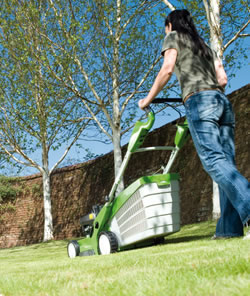Post category: Mowing
Apart from feeding, the secret of a good lawn is correct mowing – frequent, regular mowing, starting early in the year and finishing late.
Start in late February or early March. Around that time there is usually a dry spell when the ground is firm enough and the grass dry enough to cut. Continue mowing at fortnightly intervals until May, when weekly mowing becomes necessary.

Regular mowing is the key to success
Mow frequently and there will be less grass to remove each time. Continue weekly mowing through the summer, except in hot, dry weather, when growth eases off.
Fortnightly mowing is adequate in September and October. Continue into November if the ground is still firm. Even in winter, if there is a dry, mild spell, it is a good idea to ‘top’ the grass. Above all, avoid irregular mowing – it weakens the grass and encourages weeds and moss.
The first mowing in early spring should just be a trim with the blades set high. Gradually lower the blades until the desired height is reached. Do not be tempted to mow very tightly. Very tight mowing weakens the grass unless it is well fed and cared for.
A mowing height of between two and five centimetres is ideal for most Irish lawns – the second lowest and second highest setting on most mowers. The higher level is ideal for rougher lawns and those getting a lot of wear. The lower level is suitable for good quality lawns. The desired height of cut should be maintained when weekly mowing starts.
Raise the blades during drought spells, and towards the end of the season. Any winter ‘topping’ should be done at the highest setting.
The grass-box, or grass-bag, should always be used, unless a mulching mower is used. Mowing is easier, faster and safer, and weed control is improved by collecting seed heads instead of spreading them.
Mulching mowers give good results with dry grass but the mower model should be dual purpose – capable of carrying a grass bag for use when the grass is damp, which is likely early and late in the season.


